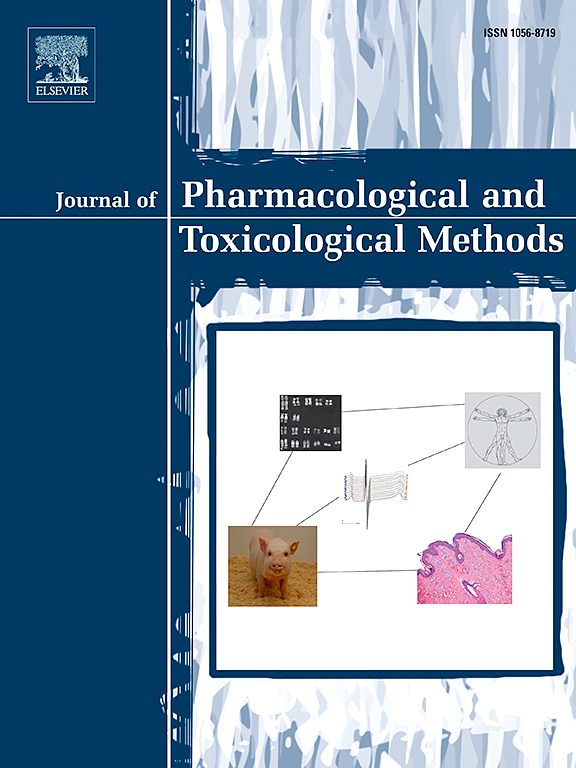米特拉吉宁和7-羟米特拉吉宁对大鼠滥用责任和呼吸作用的评估
IF 1.3
4区 医学
Q4 PHARMACOLOGY & PHARMACY
Journal of pharmacological and toxicological methods
Pub Date : 2025-05-01
DOI:10.1016/j.vascn.2025.107624
引用次数: 0
摘要
Kratom (Mitragyna speciosa)是一种天然产品,在美国大多数州随处可见,几乎没有监管。许多人使用克拉托姆自我治疗疼痛和阿片类药物依赖,但科学证据滞后。2011年至2017年期间,美国毒物控制中心报告了1807例克拉托姆暴露。其中大多数发生在过去两年(65% %),并导致严重的医疗后果(51.9% %)。由于向中毒控制中心报告的不良反应可能归因于kratom中鉴定的40多种生物碱中的任何一种,因此迫切需要评估kratom植物中发现的活性成分的安全性。在这些生物碱中,米特ragynine是植物中最普遍的,而7-羟基米特ragynine是一种与μ -阿片受体有很强亲和力的次要生物碱。本研究旨在评估米特拉金和7-羟米特拉金的滥用潜力及其对呼吸参数的影响。在颈静脉导管植入的雄性和雌性Sprague Dawley大鼠中,建立了静脉(i.v)自我给药阿片类激动剂瑞芬太尼(1 μg/kg/输注),并对动物进行了多组分范式的训练,其中每种组分都有不同的剂量。一旦瑞芬太尼反应稳定,就用瑞芬太尼代替测试化合物(米特拉吉宁、7-羟米特拉吉宁和芬太尼)。呼吸实验采用受试者内设计,并在单独的雄性和雌性大鼠队列中进行了为期7天的药物洗脱期。在给药前和给药后,使用全身容积描记仪测量呼吸频率、潮气量和分钟通气量。当米特拉吉宁取代瑞芬太尼时,米特拉吉宁抑制了瑞芬太尼相关的杠杆反应。然而,7-羟米特拉吉宁或芬太尼替代在瑞芬太尼相关水平上保持应答。在呼吸实验中也观察到同样的情况,米特拉吉宁没有产生呼吸抑制,但7-羟基米特拉吉宁导致了与芬太尼相似的呼吸抑制。这些结果与体外和体内文献一致,表明米特拉吉宁具有低滥用潜力,不会导致呼吸抑制。然而,7-羟米特拉吉宁可能存在滥用和呼吸抑制的危险。本文章由计算机程序翻译,如有差异,请以英文原文为准。
Assessment of abuse liability and respiratory effects of mitragynine and 7-hydroxymitragynine in rats
Kratom (Mitragyna speciosa) is a natural product ubiquitously available in most US states with little, if any, regulation. Many use kratom to self-treat pain and opioid dependence, yet scientific evidence is lagging. Between 2011 and 2017 there were 1807 kratom exposures reported to poison control centers in the United States. Most of them occurred in the last two years (65 %) and resulted in a serious medical outcome (51.9 %). There is a pressing need to evaluate the safety of the active components found in the kratom plant, as the adverse effects reported to poison control centers could be attributed to any of the 40+ alkaloids identified within kratom. Among these alkaloids, mitragynine is the most prevalent in the plant, while 7-hydroxymitragynine, a minor alkaloid with a strong affinity for the mu-opioid receptor, has also been identified. This study aims to evaluate both the potential for abuse and the impact on respiratory parameters of mitragynine and 7-hydroxymitragynine.In jugular catheter-implanted male and female Sprague Dawley rats, intravenous (i.v.) self-administration for the opioid agonist remifentanil (1 μg/kg/infusion), was established and animals were trained on a multi-component paradigm in which different doses were available at each component. Once remifentanil response was stable, remifentanil was substituted for the test compounds (mitragynine, 7-hydroxymitragynine, and fentanyl). Respiratory experiments were conducted using a within-subjects design and included a 7-day drug washout period between sessions on a separate cohort of male and female rats. Respiratory frequency, tidal volume, and minute ventilation were measured, both pre and post-drug administration, using whole-body plethysmography in unrestrained animals. When mitragynine was substituted for remifentanil, mitragynine suppressed remifentanil-associated lever responses. However, either 7-hydroxymitragynine or fentanyl substitution maintained responding on the remifentanil-associated lever. This same profile was observed in respiration experiments in which mitragynine failed to produce respiratory depression, but 7-hydroxymitragynine resulted in respiratory depression similar to fentanyl. These results are in agreement with the in vitro and in vivo literature indicating mitragynine has low abuse potential and does not result in respiratory depression. However, 7-hydroxymitragynine may be subject to abuse liability and respiratory depression.
求助全文
通过发布文献求助,成功后即可免费获取论文全文。
去求助
来源期刊

Journal of pharmacological and toxicological methods
PHARMACOLOGY & PHARMACY-TOXICOLOGY
CiteScore
3.60
自引率
10.50%
发文量
56
审稿时长
26 days
期刊介绍:
Journal of Pharmacological and Toxicological Methods publishes original articles on current methods of investigation used in pharmacology and toxicology. Pharmacology and toxicology are defined in the broadest sense, referring to actions of drugs and chemicals on all living systems. With its international editorial board and noted contributors, Journal of Pharmacological and Toxicological Methods is the leading journal devoted exclusively to experimental procedures used by pharmacologists and toxicologists.
 求助内容:
求助内容: 应助结果提醒方式:
应助结果提醒方式:


